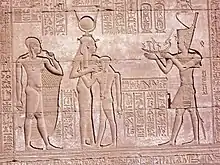Roman pharaoh
The Roman pharaohs,[1] rarely referred to as ancient Egypt's Thirty-fourth Dynasty,[2][n 1] is the term sometimes used for the Roman emperors in their capacity as rulers of Egypt, especially in Egyptology. After Egypt was incorporated into the Roman Empire in 30 BC, the people and especially the priesthood of the country continued to recognize the Roman emperors as pharaohs, according them traditional pharaonic titularies and depicting them with traditional pharaonic garb, engaging in traditional pharaonic activities, in artwork and at temples throughout Egypt.

Although the Egyptians themselves considered the Romans to be their pharaohs and the legitimate successors of the ancient pharaohs, the emperors themselves never adopted any pharaonic titles or traditions outside of Egypt, as these would have been hard to justify in the Roman world at large. Most emperors probably cared little of the status accorded to them by the Egyptians, with emperors rarely visiting the province more than once in their lifetime. Their role as god-kings was only ever officially acknowledged by the Egyptians themselves. This was a sharp contrast to the preceding dynasty of pharaohs of Hellenistic Ptolemaic Kingdom, who had spent the majority of their lives in Egypt, ruling from Alexandria. Pharaohs before Egypt's incorporation into the Achaemenid Empire in the Late Period had also all ruled the country from within Egypt. However, Roman Egypt was governed differently from other Roman provinces, with emperors hand-picking governors for the region and often treating it more like a personal possession than a province.
Though not all Roman emperors were recognized as pharaohs, Egyptian religion demanded the presence of a pharaoh to act as the intermediate between humanity and the gods. The Romans being seen as pharaohs proved to be the most simple solution, and was similar to how the Persians had been regarded as pharaohs centuries prior (constituting the Twenty-seventh and Thirty-first dynasties).
Though Egypt continued to be a part of the Roman Empire until it was conquered by the Rashidun Caliphate in 641 AD, the last Roman emperor to be conferred the title of pharaoh was Maximinus Daia (reigned 311–313 AD). By his time, the view of Romans as pharaohs had already been declining for some time due to Egypt being on the periphery of the Roman Empire (in contrast to the traditional pharaonic view of Egypt as the center of the world). The spread of Christianity throughout the empire in the 4th century, and the transformation of Egypt's capital Alexandria into a major Christian center, decisively ended the tradition, due to the new religion being incompatible with the traditional implications of being pharaoh.
History
Cleopatra VII had affairs with Roman dictator Julius Caesar and Roman general Mark Antony, but it was not until after her 30 BC suicide (after Mark Antony was defeated by Octavian, who would later be Emperor Augustus Caesar) that Egypt became a province of the Roman Republic. Subsequent Roman emperors were accorded the title of pharaoh, although exclusively while in Egypt. As such, not all Roman emperors were recognized as pharaohs. Although Octavian made a point of not taking the Pharaonic crown when he conquered Egypt, which would have been difficult to justify to the wider empire considering the vast amount of propaganda which he had spread about the "exotic" behavior of Cleopatra and Antony,[3] the native population of Egypt regarded him as the pharaoh succeeding Cleopatra and Caesarion. Depictions of Octavian, now called Augustus, in traditional pharaonic garbs (wearing different crowns and the traditional kilt) and sacrificing goods to various Egyptian gods were made as early as around 15 BC and they are present in the Temple of Dendur, built by Gaius Petronius, the Roman governor of Egypt.[4] Even earlier than that, Augustus had been accorded royal titles in the Egyptian version of a 29 BC stele made by Cornelius Gallus, despite royal titles not being present in the Latin or Greek-language versions of the same text.[5]
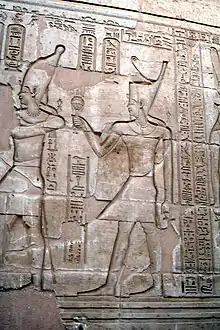
Unlike the preceding Ptolemaic pharaohs and pharaohs of other previous foreign dynasties, the Roman emperors were rarely physically present in Egypt. As such, the traditional role of the pharaoh, a living embodiment of the gods and cosmic order, was somewhat harder to justify; an emperor rarely visited the province more than once in their lifetime, a sharp contrast to previous pharaohs who had spent a majority of their lives in Egypt. Even then, Egypt was hugely important to the empire as it was highly fertile and the richest region of the Mediterranean. Egypt was governed differently from other provinces, emperors treating it more like a personal possession than a province; hand-picking governors and administering it without the Roman Senate's interference - no senator was ever named governor of Egypt and they were even barred from visiting the province without explicit permission.[6]
Vespasian was the first emperor since Augustus to appear in Egypt.[7]:13 At Alexandria he was hailed as pharaoh; recalling the welcome of Alexander the Great at the Oracle of Zeus-Ammon of the Siwa Oasis, Vespasian was proclaimed the son of the creator-deity Amun (Zeus-Ammon), in the style of the ancient pharaohs, and an incarnation of Serapis in the manner of the Ptolemies.[7]:13–14 As pharaonic precedent demanded, Vespasian demonstrated his divine election by the traditional methods of spitting on and trampling a blind and crippled man, thereby miraculously healing him.[7]:14 (This Egyptian tradition of healing is related to the healing the man blind from birth, one of the miracles of Jesus of Nazareth.)[7]:14
To the Egyptians, their religion demanded that there was a pharaoh to act as the intermediate between the gods and humanity. As such, the emperors continued to be regarded as pharaohs since this proved the most simple solution, disregarding the actual political situation, similar to how Egypt had regarded the Persians or Greeks before the Romans. The abstract nature of the role of these "Roman pharaohs" ensured that the priests of Egypt could demonstrate their loyalty both to their traditional ways and to the new foreign ruler. The Roman emperors themselves mostly ignored the status accorded to them by the Egyptians; in Latin and Greek their titles continued to be Roman only (Imperator in Latin and Autokrator in Greek) and their role as god-kings was only ever acknowledged domestically by the Egyptians themselves.[8]
As Christianity became more and more accepted within the empire, eventually becoming the state religion, emperors no longer found it possible to accept the traditional implications of being pharaoh (a position firmly rooted in the Egyptian religion) and by the early 4th century, Alexandria itself, the capital of Egypt since the time of Alexander the Great, had become a major center of Christianity. By this point, the view of the Romans as pharaohs had already declined somewhat; Egypt being on the periphery of the Roman Empire was much different from the traditional pharaonic view of Egypt as the center of the world. This was evident in the imperial pharaonic titulatures; though early emperors had been given elaborate titulatures similar to those of the Ptolemies and native pharaohs before them, emperors from Commodus (reigned 180–192 AD) onwards were usually given just a nomen, though still written within a cartouche (as all pharaonic names were).[9] Although there continued to be Roman emperors for centuries, until the Fall of Constantinople in 1453 AD, and Egypt continued to be a part of the empire until 641 AD, the last Roman emperor to be conferred the title of pharaoh was Maximinus Daia (reigned 311–313 AD).[10]
Despite actual dynastic relationships (there were at least four distinct dynasties of Roman emperors between Augustus and Maximinus Daia), the period of Roman rule over Egypt in its entirety is sometimes referred to as the Thirty-fourth Dynasty.[2] Some nineteenth century Coptic scholars, such as Mikhail Sharubim and Rifa'a al-Tahtawi, split the Roman emperors into two dynasties, a Thirty-fourth Dynasty for pagan emperors and a Thirty-fifth Dynasty encompassing Christian emperors from Theodosius I to the Muslim conquest of Egypt in 641 AD, although no Christian Roman emperor was ever referred to as pharaoh by the population of ancient Egypt.[11]
List of emperors recognized as pharaohs
The titulature (most of them incomplete) of all emperors, which keeps in line with pharaonic titles of previous periods, derives from Beckerath (1999).[9]
Julio-Claudian Dynasty (30 BC–68 AD)
| Depiction | Name & reign | Comments | Horus name | Golden Horus | Prenomen | Autokrator | Nomen/Kaisaros |
|---|---|---|---|---|---|---|---|
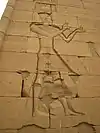 |
Augustus 30 BC–14 AD (44 years) |
Egypt was incorporated by Augustus into the Roman Republic in 30 BC after the deaths of Cleopatra and Caesarion. In 27 BC, Augustus became the first Roman emperor. | Hor-Tjema wer pehty hunu bener merut heqa heqau setep en Ptah Nenu it netjeru "The sturdy-armed one with great strength, the youth sweet of love, ruler of rulers, chosen of Ptah and Nun, the father of the gods" |
– | Heqa heqau setep en Ptah "Ruler of rulers, chosen by Ptah" |
Autokrator Emperor |
Kaisaros Caesar |
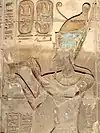 |
Tiberius 14–37 AD (22 years) |
Adoptive son of Augustus. | Hor-Tjemaa wer pehty hunu nefer bener merut heqa heqau setep en Ptah nenu it netjeru "The sturdy-armed one with great strength, the perfect and popular youth, ruler of rulers, chosen of Ptah and Nun, the father of the gods" |
– | – | – | Tyberys Tiberius |
| Caligula 37–41 AD (3 years, 10 months) |
Son of Germanicus, the adoptive son of Tiberius. | Hor-Kanakht iakhw setut Ra Iah "The strong bull, the light of the sun and the moon's rays" |
– | – | Autokrator heqa heqau mery Ptah Aset "Emperor and ruler of rulers, beloved by Ptah and Isis" |
Kyseres Kernykes ankh djet "Caesar Germanicus, living forever" | |
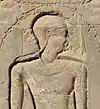 |
Claudius 41–54 AD (13 years, 8 months) |
Uncle of Caligula. | Hor-Kanakht djed iakh shu (em) Akhet "The strong bull of the stable moon on the horizon" (?) |
– | – | Autokrator heqa heqau mery Aset Ptah "Emperor and ruler of rulers, beloved of Isis and Ptah" |
Tiberios Klaudios Tiberius Claudius |
 |
Nero 54–68 AD (13 years, 8 months) |
Adoptive son of Claudius. | Hor-Tjemaa hui khasut, wer nakhtu Baqet, heqa heqau, setep en Nenu merur "The sturdy-armed one who struck the foreign lands, victorious for Egypt, ruler or rulers, chosen of Nun who loves him" |
– | Heqa heqau setep en Ptah mery Aset "Ruler of rulers, chosen by Ptah, beloved of Isis" |
Autokrator Neron Emperor Nero |
Neron Nero |
| Depiction | Name & reign | Comments | Horus name | Golden Horus | Prenomen | Autokrator | Nomen/Kaisaros | ||
|---|---|---|---|---|---|---|---|---|---|
| Galba 68–69 AD (7 months) |
Non-dynastic Roman emperor, seized power after Nero's suicide. | – | – | – | Autokrator Servios Galbas Emperor Servius Galba |
– | |||
| Otho 69 AD (3 months) |
Non-dynastic Roman emperor, appointed by the Praetorian Guard. | – | – | – | – | Markos Othon Marcus Otho | |||
| Roman emperor Vitellius, who ruled for eight months between Otho and Vespasian, is not accorded any Pharaonic titles in known Egyptian sources. | |||||||||
Flavian Dynasty (69–96 AD)
| Depiction | Name & reign | Comments | Horus name | Golden Horus | Prenomen | Autokrator | Nomen/Kaisaros |
|---|---|---|---|---|---|---|---|
| Vespasian 69–79 AD (9 years, 6 months) |
Seized power of the Roman Empire with the eastern legions. | – | – | – | – | Vespasianos Vespasianus | |
| Titus 79–81 AD (2 years, 2 months) |
Son of Vespasian. | Hor-Hunu nefer bener merut "The perfect and popular youth" |
– | – | Autokrator Titos Kaisaros Emperor Titus Caesar |
Titos Titus | |
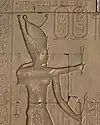 |
Domitian 81–96 AD (15 years) |
Son of Vespasian. | Hor-Hunu nekhet itj em sekhemef "The mighty youth, his power will be stronger" (?) |
User renput Aa nakhtu "Rich in years and great of victories" |
Hor sa Aset mery netjeru nebu "Horus, son of Isis, beloved of the gods" (?) |
– | Dominitianos Sebastos Kaisaros "The Venerable Dominitianus Caesar" |
Nerva-Antonine Dynasty (96–192 AD)
| Depiction | Name & reign | Comments | Horus name | Golden Horus | Prenomen | Autokrator | Nomen/Kaisaros | ||
|---|---|---|---|---|---|---|---|---|---|
| Nerva 96–98 AD (1 year, 4 months) |
Appointed by the Roman Senate. | – | – | – | – | Nervas netikhu Nerva Augustus | |||
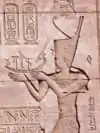 |
Trajan 98–117 AD (19 years, 6 months) |
Adoptive son of Nerva. Under Trajan, the Roman Empire reached its greatest extent. | – | – | – | Autokrator Kaisaros Nerouas Emperor Caesar Nerva |
Germanikos Dakikos ankh djet "Germanicus Dacian, who lives forever" | ||
| Hadrian 117–138 AD (20 years, 10 months) |
Adoptive son of Trajan. | – | – | – | – | Hadrianos Kaisaros Hadrianus Caesar | |||
| Antoninus Pius 138–161 AD (22 years, 6 months) |
Adoptive son of Hadrian. | Incomplete Hor-Nefer... |
– | – | Autokrator Kaisaros Titos Ailitos Adrianos Emperor Caesar Titus Aelius Hadrianus |
Antoninos netikhu ankh djet "Antoninus Augustus, living forever" | |||
| Lucius Verus 161–169 AD (8 years) |
Adoptive son of Antoninus Pius, co-ruler with Marcus Aurelius. | – | – | – | – | Loukio(s) Aurelio(s) wer aa ankh djet "Lucius Aurelius, great life forever" | |||
| Marcus Aurelius 161–180 AD (19 years) |
Adoptive son of Antoninus Pius, co-ruler with Lucius Verus until 169 AD. | – | – | – | Autokrator Kaisaros Mark(os) Aurelio(s) Antonin(os) Emperor Caesar Marcus Aurelius Antoninus |
Antonino(s) Antoninus | |||
| Commodus 180–192 AD (12 years) |
Son of Marcus Aurelius. | – | – | – | Markos Aure(l)ios Komodos Antoninos Marcus Aurelius Commodus Antoninus | ||||
| The non-dynastic Roman emperors Pertinax and Didius Julianus, who ruled for two months each between Commodus and Septimius Severus, are not accorded any Pharaonic titles in known Egyptian sources. | |||||||||
Severan Dynasty (193–235 AD)
| Depiction | Name & reign | Comments | Horus name | Golden Horus | Prenomen | Autokrator | Nomen/Kaisaros | ||
|---|---|---|---|---|---|---|---|---|---|
| Septimius Severus 193–211 AD (17 years, 9 months) |
Seized power with the support of the Pannonian legions. | – | – | – | – | Seoueros netikhu Severus Augustus | |||
 |
Caracalla 211–217 AD (6 years) |
Son of Septimius Severus. | – | – | – | – | Antoninos netikhu Antoninus Augustus | ||
| Geta 211 AD (10 months) |
Son of Septimius Severus, co-ruler with Caracalla. | – | – | – | – | Geta(s) netikhu Geta Augustus | |||
| Macrinus 217–218 AD (1 year, 1 month) |
Usurped power, unrelated to the Severan dynasty. | – | – | – | – | Makrino(s) netikhu Macrinus Augustus | |||
| Diadumenian 218 AD (1 month) |
Son of, and co-ruler with, Macrinus. | – | – | – | – | Diadoumenianos Diadumenianus | |||
| The Severan emperors Elagabalus and Severus Alexander, who ruled respectively for three and thirteen years after Macrinus, are not accorded any Pharaonic titles in known Egyptian sources. | |||||||||
Crisis of the Third Century (235–284 AD)
| Depiction | Name & reign | Comments | Horus name | Golden Horus | Prenomen | Autokrator | Nomen/Kaisaros | ||
|---|---|---|---|---|---|---|---|---|---|
| Emperors Maximinus Thrax (235–238 AD) Gordian I and Gordian II (both 238 AD), Pupienus and Balbinus (both 238 AD) and Gordian III (238–244 AD) are not accorded any Pharaonic titles in Egyptian sources. | |||||||||
| Philip the Arab 244–249 AD (5 years) |
Non-dynastic. | – | – | – | – | Philippos netikhu Philippus Augustus | |||
| Emperor Philippus II (247–249 AD), co-ruler with Philip the Arab, is not accorded any Pharaonic titles in known Egyptian sources. | |||||||||
| Decius 249–251 AD (2 years) |
Non-dynastic, defeated and killed Philip the Arab. | – | – | – | – | Dekios netikhu Decius Augustus | |||
| Emperors Herennius Etruscus (251 AD), Hostilian (251 AD), Trebonianus Gallus (251–253 AD), Volusianus (251–253 AD) and Aemilian (253 AD) are not accorded any Pharaonic titles in known Egyptian sources. | |||||||||
| Valerian 253–260 AD (7 years) |
Non-dynastic. | – | – | – | – | Oualerianos Valerianus | |||
| Emperors Gallienus (253–268 AD), Saloninus (260 AD), Claudius Gothicus (268–270 AD), Quintillus (270 AD), Aurelian (270–275 AD), Tacitus (275–276 AD), Florianus (276 AD), Probus (276–282 AD), Carus (282–283 AD), Carinus (283–285 AD) and Numerian (283–284 AD) are not accorded any Pharaonic titles in known Egyptian sources. | |||||||||
Tetrarchy (284–313 AD)
| Depiction | Name & reign | Comments | Horus name | Golden Horus | Prenomen | Autokrator | Nomen/Kaisaros |
|---|---|---|---|---|---|---|---|
| Diocletian 284–305 AD (20 years, 5 months) |
Proclaimed emperor after the death of Numerian. The first emperor to divide the Roman Empire into East and West. | – | – | – | – | Diokletian(os) Diocletianus | |
| Maximian 286–305 AD (19 years, 1 month) |
Appointed Western Roman Emperor by Diocletian. | – | – | – | – | Maksimiano(s) Maximianus | |
| Galerius 305–311 AD (6 years) |
Adoptive heir of Diocletian. | – | – | – | – | Kaisaros Iouio(s) Maksimio(s) Caesar Julius Maximius | |
| Maximinus Daia 311–313 AD (2 years) |
Adoptive heir of Galerius. The final Roman emperor (and ruler overall) to be accorded the title of pharaoh. | – | – | – | – | Incomplete Kaisaros... Mak(sim)inos Caesar ... Maximinus |
Notes
- The last dynasty identified with a number by most egyptologists is the Thirty-first Dynasty (when the Persians ruled Egypt for the second time). If the Romans are numbered as the "Thirty-fourth Dynasty", the Argead dynasty of Alexander the Great is considered the Thirty-second Dynasty and the Ptolemaic Kingdom is considered the Thirty-third Dynasty.
References
- Rossini 1989, p. 6.
- Loftie 2017.
- Scott 1933, pp. 7–49.
- Marinelli 2017.
- Minas-Nerpel & Pfeiffer 2008, pp. 265–298.
- Wasson 2016.
- Ritner, Robert K. (1998). "Egypt under Roman rule: the legacy of ancient Egypt". In Petry, Carl F. (ed.). Islamic Egypt 640–1517. The Cambridge History of Egypt. 1: (1 ed.). Cambridge University Press. pp. 1–33. doi:10.1017/chol9780521471374.002. ISBN 978-1-139-05337-2. Retrieved 2021-01-26.CS1 maint: extra punctuation (link)
- O'Neill 2011.
- von Beckerath 1999, pp. 248–267.
- Vernus & Yoyotte 2003, pp. 238–256.
- Reid 2003, pp. 284.
Cited bibliography
- von Beckerath, Jürgen (1999). Handbuch der ägyptischen Königsnamen. Deutscher Kunstverlag. ISBN 978-3422008328.
- Loftie, William John (2017). A Ride in Egypt. Jazzybee Verlag.
- Minas-Nerpel, Martina; Pfeiffer, Stefan (2008), "Establishing Roman rule in Egypt: The trilingual stela of C. Cornelius Gallus from Philae", Proceedings of the International Conference, Hildesheim, Roemer- and Plizaeus-Museum: 265–298
- O'Neill, Sean J. (2011), "The Emperor as Pharaoh: Provincial Dynamics and Visual Representations of Imperial Authority in Roman Egypt, 30 B.C. - A.D. 69", Dissertions of the University of Cincinnati
- Reid, Donald Malcolm (2003). Whose Pharaohs? Archaeology, Museums, and Egyptian National Identity from Napoleon to World War I. University of California Press. ISBN 9780520240698.
- Rossini, Stéphane (1989). Egyptian Hieroglyphics: How to Read and Write Them. Dover Publications. ISBN 978-0486260136.
- Scott, Kenneth (1933), "The Political Propaganda of 44-30 B. C.", Memoirs of the American Academy in Rome, 11: 265–298, doi:10.2307/4238573, JSTOR 4238573
- Vernus, Pascal; Yoyotte, Jean (2003). The Book of the Pharaohs. Cornell University Press. ISBN 9780801440502.
Cited web sources
- Marinelli, Christina. "Stories in Stone: How an Egyptian Temple Tells Its Story". Retrieved 2 August 2019.
- Wasson, Donald L. "Roman Egypt - Ancient History Encyclopedia". Retrieved 2 August 2019.
